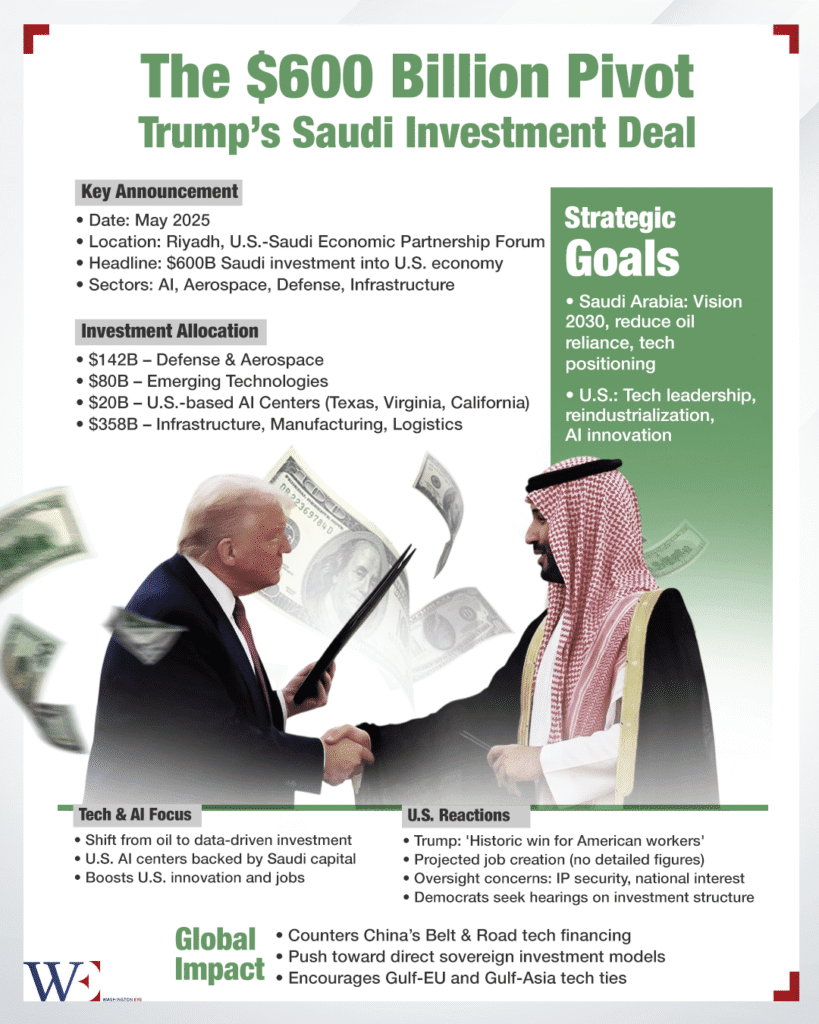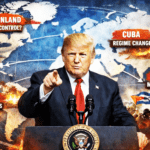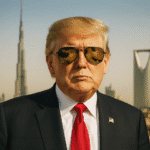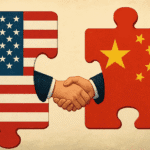President Donald J. Trump’s announcement of a $600 billion investment commitment from Saudi Arabia has emerged as one of the most significant foreign economic developments in recent U.S. history. Unveiled during his high-profile visit to Riyadh for the U.S.-Saudi Economic Partnership Forum, the agreement reflects not only deepening bilateral economic ties but also a reshaping of global capital flows and geopolitical alliances. According to a White House Factsheet, the commitment spans key sectors such as artificial intelligence, aerospace, defense, and critical infrastructure.
Recalibrating U.S.-Saudi Strategic Relations
The $600 billion deal cements a new era of U.S.-Saudi engagement, defined more by economic pragmatism than traditional security guarantees. The agreement emerged from months of quiet diplomatic and commercial negotiation, with Crown Prince Mohammed bin Salman viewing the investment as both a hedge against regional instability and a long-term bid for technological influence.
The sheer size of the investment — triple the amount of Saudi pledges during Trump’s first term — signals Riyadh’s intent to secure a more stable and technologically integrated future with Washington. In particular, the $142 billion allocated to defense and aerospace reflects both nations’ concerns about Iran’s growing regional assertiveness and China’s influence in Gulf security architectures.
Tech and AI: The New Core of Bilateral Investment
The deal notably earmarks $80 billion for emerging technologies and $20 billion for building U.S.-based AI centers, signaling a pivot in the nature of U.S.-Saudi economic cooperation. Unlike past investment pacts dominated by fossil fuel and energy infrastructure, this new agreement is forward-facing.
As stated in the White House factsheet, AI centers will be housed in locations across Texas, Virginia, and California, aiming to position the U.S. as the global leader in ethical AI research and deployment. Saudi capital is, in effect, underwriting part of America’s technological reindustrialization, a shift that analysts say will also help counter China’s dominance in the field.
Economic experts argue this focus reflects a strategic calculation by Riyadh: as oil-based influence wanes, technology and data will define 21st-century power. The Kingdom’s Vision 2030 plan already placed AI at its core, and this U.S. partnership gives it a transnational foothold in shaping that future.
Political and Economic Implications in the U.S.
Domestically, the announcement delivers a powerful narrative for President Trump ahead of a contentious election cycle. Framing it as a “historic win for American workers”, Trump claimed the agreement would “create hundreds of thousands of high-paying jobs”, especially in manufacturing and defense, though specific job creation metrics were not detailed in the White House release.
However, critics have raised concerns about the political and regulatory strings that might come attached. With such large-scale Saudi investment flowing into sensitive areas like AI and defense, there are growing calls for oversight mechanisms to safeguard U.S. intellectual property and national security.
Moreover, some economists caution that while foreign investment can bolster innovation, it may also crowd out domestic capital or deepen dependency on external partners for key industries. The bipartisan reception in Congress has been cautiously supportive, though Democrats are demanding hearings to better understand the investment’s structure and strategic implications.
Shifting Global Investment Dynamics
This investment signals a broader trend of sovereign wealth reallocations toward more assertive and diversified portfolios. With Gulf states increasingly bypassing multilateral institutions to cut direct bilateral deals, this move may inspire similar partnerships between Saudi Arabia and tech-savvy economies like South Korea or Germany.
Geopolitically, this is a challenge to the China-led Belt and Road Initiative, which has long dominated high-tech infrastructure financing across Asia and Africa. By anchoring Saudi investment within the U.S. economy, Trump is effectively rebalancing Gulf capital flows in the context of the larger U.S.-China rivalry.
The move also places pressure on the European Union to match American agility in attracting large-scale capital. If replicated, this model could represent a new paradigm in foreign direct investment — less transactional, more strategic, and increasingly shaped by technological frontiers.
A Final Note: A High-Stakes Gamble with Global Consequences
President Trump’s Saudi investment deal is not merely a diplomatic or economic victory — it is a calculated bet on a new world order defined by technology, defense, and capital mobility. Whether this leads to sustained American innovation and strategic stability, or engenders new forms of foreign entanglement, remains to be seen. But what is certain is that the ripples of this $600 billion commitment will extend far beyond American shores.














